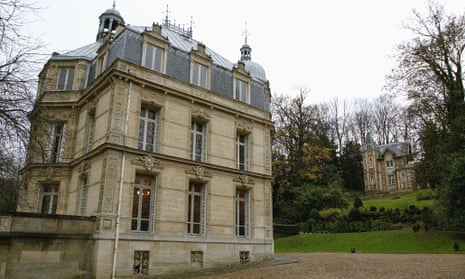As the Three Musketeers avowed, it was “all for one, one for all” (tous pour un, un pour tous).
The device, created by Alexandre Dumas père, the French writer, summed up the brotherly solidarity between Athos, Porthos, Aramis and their friend D’Artagnan, a near-penniless adventurer.
Today it neatly encapsulates the pressing need for some modern-day fraternity, in the form of hard cash, to stop the author’s historic home from falling down.
Local campaigners are desperately seeking funds to save the Chateau de Monte-Cristo – a three-storey, neo-renaissance castle, which Dumas described as his personal “paradise on Earth” – from decrepitude or rapacious property developers.
“The chateau is worth saving,” Frédérique Lurol, its director, told the Guardian, during a private tour of the property on Friday.
Lurol pointed to damp stains from the leaky roof on the ornate plasterwork of one ceiling, as well as cracks in the north African-inspired Moors Salon – restored by King Hassan II of Morocco – and peeling paint arising from the water-logged foundations. “We have to act now because as you can see the situation is becoming pretty catastrophic.”
Dumas was at the height of his fame in 1844, after the publication of Les Trois Mousquetaires, when he acquired a piece of land used as a vineyard near Saint-Germain-en-Laye, 20km west of Paris.
Seduced by the bucolic atmosphere of the area overlooking the Seine, he had a magnificent property built by Hippolyte Durand, a celebrated architect of the day.
Dumas told Durand: “Right here, you’re going to make an English park in the middle of which I want a Renaissance chateau facing a gothic pavilion, surrounded by water.”
In July 1847, one year after Dumas completed his classic Le Comte de Monte-Cristo, the chateau was finished. Dumas named it after what would become one of his most successful works and invited 600 friends, admirers and sundry hangers-on for a lavish housewarming party.
The writer liked a good party and it was to be the first of many sumptuous fetes and gastronomic dinners at the castle, before Dumas’s fortune ran out.
In order to escape the revelries and write, Dumas set up an office in an impressive neo-gothic pavilion in the garden, named the Chateau d’If.
While grandly called a “chateau”, the main house barely qualifies as a mansion. Its facades, decorated with floral motifs, angels and musical instruments as well as strange mythical animals, compensate for its modest size. Above each ground-floor window is a sculpture of a celebrated historical writer, including Shakespeare.
High above the front door is the Dumas family shield . It has three eagles and the author’s motto: J’aime qui m’aime (I love those who love me).
Honoré de Balzac wrote that the Chateau de Monte-Cristo was one of the “most delicious sweet-box folies to ever be made”. It certainly cost a small fortune: about 500,000 gold francs at a time when a Paris labourer earned two or three francs a day.
However in 1848, having squandered the fortune made from writing on high living and women – scholars have suggested he had 40 mistresses – Dumas was forced to sell the property for just 31,000 francs. He fled his remaining creditors and went into exile in Belgium in 1851.
The property was rented to the British School of Paris in the 1950s and 60s before falling into ruin. In 1969 its owners, a property development company, applied to demolish the chateau and replace it with 400 flats. It was only saved when three local authorities stepped in to buy it.
After a major renovation 20 years ago, the association that runs the chateau now needs €921,000 (£664,000) to carry out essential repairs. Unfortunately, since the appeal for funds was launched two weeks ago only €1,800 has been collected.
“For some reason the Chateau de Monte-Cristo has always been undervalued as a historical asset,” Lurol added. “Parts of the property, including some of the rooms, are listed as part of the national heritage but, strangely, not the whole chateau or estate. So while we have some public money, we still need to raise half ourselves.
“We are calling it an appeal for funds, but in fact it’s an urgent call for help. Having saved the chateau from destruction once, we have to save it again for future generations.”

Comments (…)
Sign in or create your Guardian account to join the discussion